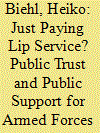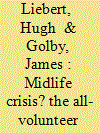| Srl | Item |
| 1 |
ID:
141169


|
|
|
|
|
| Summary/Abstract |
Despite the importance of public opinion in supporting the military and their missions, little is known about how the UK public perceive their Armed Forces. This article reviews and evaluates available research and opinion poll data of public attitudes toward the UK military and situates the evidence within the civil–military gap literature. Current evidence suggests public regard for the UK Armed Forces is high despite low levels of support for the Iraq and Afghanistan missions. Public understanding of the work of the Armed Forces is limited. Nonetheless, the United Kingdom’s long history of military deployments may have given the public an “intuitive understanding” of the basic realities of the military compared with other European states. There are indications of differences in attitudes between the UK Armed Forces and wider British society, but no firm evidence that the civil–military “gap” has become a “gulf” as claimed by some military leaders.
|
|
|
|
|
|
|
|
|
|
|
|
|
|
|
|
| 2 |
ID:
185255


|
|
|
|
|
| Summary/Abstract |
Evidence suggests that most of the UK public appreciate currently serving UK Armed Forces personnel but are less positive in their beliefs about veterans. This research examined the social representations held by civilian participants of UK veterans and serving soldiers to understand why veterans may be seen more negatively. An open-ended word association task was completed by 234 UK participants where they were asked to provide three initial responses to the words “veteran” and “soldier” and to evaluate their responses in accordance to prototypicality. The 1,404 resultant associations were grouped into 14 thematic clusters. Using the hierarchical evocation method, the results suggest “heroizing associations” to be a defining core element for “soldier” and “veteran” but “victimizing associations” to be an element only for “veteran.” Principal component analyses suggest victimizing associations are related to war and deindividuated associations; “heroizing associations” are related to characterizations of the veteran’s personality. Implications and future directions are discussed.
|
|
|
|
|
|
|
|
|
|
|
|
|
|
|
|
| 3 |
ID:
189926


|
|
|
|
|
| Summary/Abstract |
The article presents an empirical analysis of whether, how, and why people are active to either support or protest against the Bundeswehr. Public opinion polls consistently report high levels of trust in the military. According to the social-psychological approach of participation theory, this trust should lead to corresponding actions. However, the literature on civil–military gaps claims that the majority of people pay mere lip service to soldiers rather than actively support the armed forces. No active support despite high levels of trust? In an effort to empirically test the level and the determinants of the public’s support for and protest against the military, an activity scale was included in a representative opinion poll in Germany. The analyses show that a fairly large part of the German population engages in activities that support the Bundeswehr and that public trust in the military predicts that supportive behavior. Importantly, trust in the armed forces remains a strong predictor of citizens’ activities related to the armed forces even when controlling for numerous other factors. Taken together, these findings contradict the widely shared view of a civil–military gap and instead provide empirical evidence for the social-psychological approach of participation theory.
|
|
|
|
|
|
|
|
|
|
|
|
|
|
|
|
| 4 |
ID:
151017


|
|
|
|
|
| Summary/Abstract |
Owing to regional and partisan imbalances, the U.S. military is at greater risk than at any time since the advent of the all-volunteer force of becoming estranged from significant portions of the society it serves. What—if anything—should be done? This article takes three initial steps to address this problem. First, the article examines regional and partisan representation in the U.S. military and suggests that existing imbalances are likely to grow worse over time. The article then argues that the most obvious policy response, a renewed draft, would in fact fail to adequately bridge the gap. Finally, the article outlines one policy response—the reassertion of nonpartisan norms—that would help to mitigate, though not close, the gap.
|
|
|
|
|
|
|
|
|
|
|
|
|
|
|
|